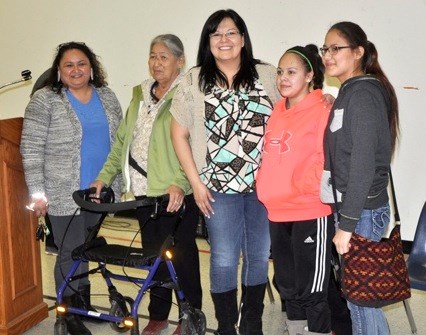Students at Sakewew High School welcomed a VIP guest to their building Tuesday afternoon, March 17.
Federation of Saskatchewan Indian Nations Chief Kimberly Jonathan was there to give a presentation to the high school students about her role as chief and how she got there, a visit organized by Sakewew staff.
Jonathan, a member of Wahpeton Dakota First Nation, is interim chief of the FSIN. She was elevated to the role after serving as vice-chief with the organization.
She took over in December when incumbent Perry Bellegarde was elected national chief of the Assembly of First Nations. She is the first female chief in the FSIN’s history.
Jonathan was introduced by Little Pine First Nation Chief Wayne Semaganis. He told the assembly he had supported her when she first ran for the FSIN.
“One of the main reasons I had, for having the comfort to help her in her path to be a leader, was because she wanted to do things right,” said Semaganis, “and I had no problems speaking up for her in public at many commission meetings and many board meetings.”
While she has risen to the top of the FSIN, her background was far from a privileged one.
Her childhood was particularly rough. She shared her story of having been sexually abused as a child, including being sexually assaulted at age 12.
She also recalled being bullied as a young girl, and had thoughts of suicide as well.
But the FSIN chief spoke about how important it was for her to move beyond the anger and pain in order to lead.
“If I hung on to all of that anger, if I hung on to all of that pain and that shame,” said Jonathan, “… I could not lead you, in love, with love, with compassion.
“Forgiveness is a gift that I give myself. Forgiveness is a gift that I give my family. Forgiveness is a gift I give my communities and now the 74 First Nations of Saskatchewan, because I’m able to have my heart, my mind, my spirit, my body open to be able to serve you the best I can.”
Her message to the Sakewew students was an encouraging one that their dreams were attainable. Jonathan urged the students to think of “the challenges, the hurts, the pains that you’ve experienced, and then think about something that you dream that you can be.”
In speaking to reporters afterwards she explained what her goal was in speaking to the students that day.
“I’m hoping my story will help empower, will help maybe one student here going through a difficult time, difficult experience, that they can say ‘she can do it,’” said Jonathan.
She also hoped it would provide some inspiration to students who themselves go through tough times.
“If sharing my truths and giving voice to what’s happened to me, and helps one youth and prevents one youth, even, from suicide, depression, low self-esteem, or anything, or helps pull them out of difficult situation, that is my hope.”




